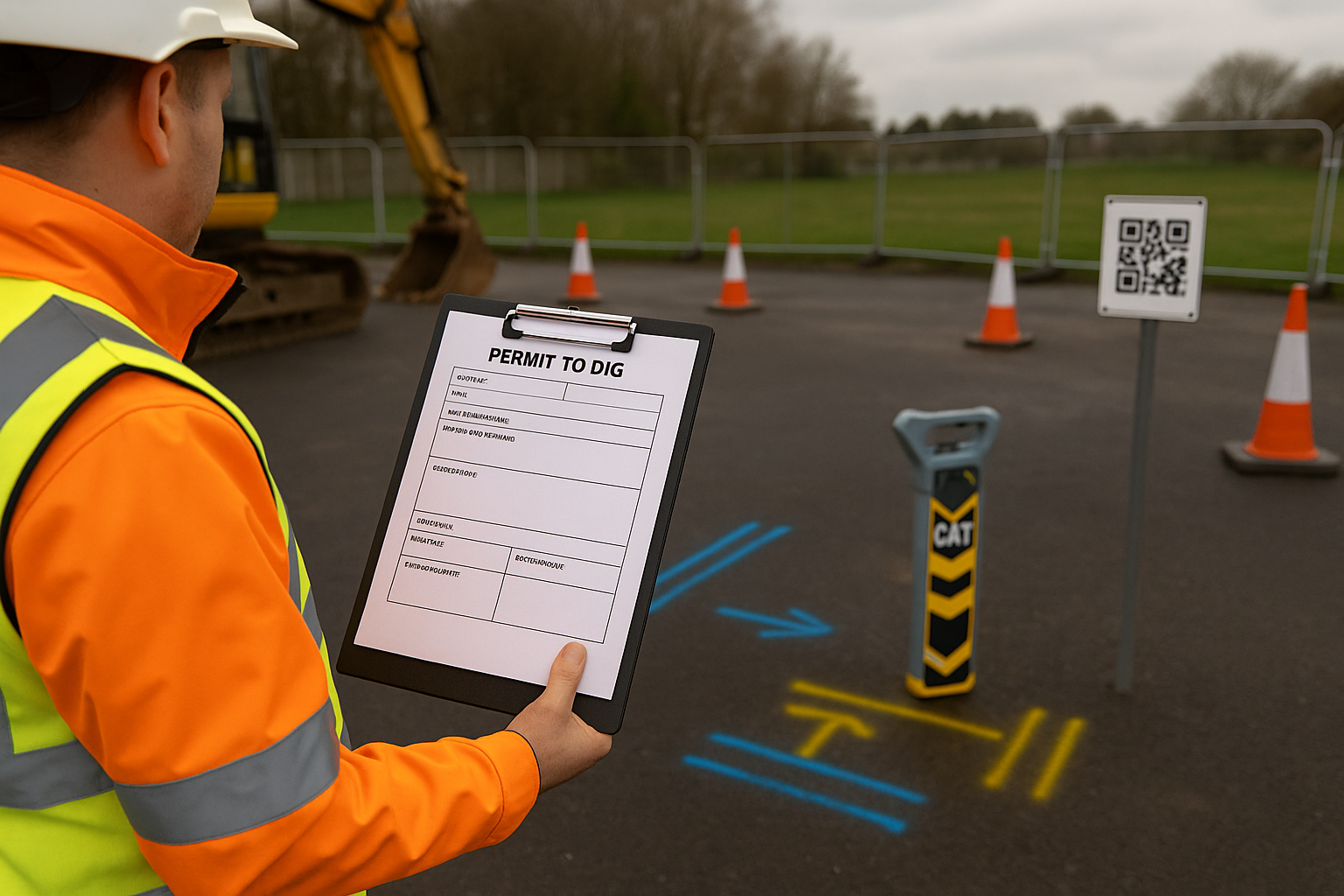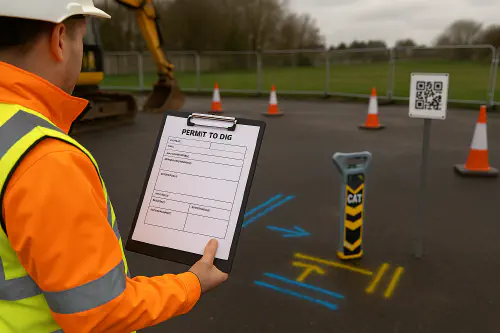
Permit to dig template: HSG47 checklist, LSBUD maps and NUAR in one simple pack
Permit to dig template: HSG47 checklist, LSBUD maps and NUAR in one simple pack
Category: Templates & Resources • Niche: Permit-to-dig, HSG47, LSBUD, NUAR, excavation safety
Contents
- What this template gives you
- Quick steps: run a permit to dig the right way
- Download: copy-and-fill template
- NUAR vs LSBUD: what to use, when
- CAT and Genny: field checklist
- Waste and spoil: simple WTN guide
- Flowchart: from plans to safe hole
- FAQs
- References

Foreman holding a Permit to Dig with CAT and Genny on a UK site
What this template gives you
This is a one-page Permit to Dig pack for small works and maintenance that your foreman can actually use. It pulls together:
- A plain‑English HSG47 checklist so you cover plan, locate, and safe dig steps
- A slot to attach LSBUD plan packs or NUAR screenshots
- A CAT and Genny daily function test and sweep log
- A space for photos of markings and trial holes
- Sign‑offs and a start/stop control so mechanical digging cannot start until checks are done
Why this matters: UK strikes are still happening. HSG47 makes it clear that plans are not enough. You need a simple, repeatable system.
Quick steps: run a permit to dig the right way
- Collect plans
- Use LinesearchbeforeUdig to request utility plans for your polygon or route. Save the confirmation sheet and all replies.
- If your client gives you NUAR access, pull the job area and export map views. NUAR is expanding and can be a primary source with client approval. See NUAR on GOV.UK.
- Scotland: use the Scottish Road Works Register/Vault via Dial before you dig.
- Plan the safe system of work
- Read HSE’s HSG47 guidance: Avoiding danger from underground services. Build your method: locating technique, tolerance zones, trial holes, insulated tools, and emergency plan.
- Site briefing and markings
- Walk the area, mark suspected routes from plans. Brief the gang. No plant starts until the permit is issued.
- Locate repeatedly
- Do a CAT and Genny functional check, then systematic sweeps in Power, Radio and Genny modes. Mark findings and uncertainties.
- Verify
- Hand dig trial holes to confirm line and depth. Adjust markings. If uncertainty remains, escalate to a PAS 128 survey.
- Control and record
- Complete sign‑offs on the permit. Attach photos of markings, trial holes, and plan screenshots. If scope changes or the permit expires, stop and re‑issue.
Download: copy-and-fill template
Copy this block into your own doc or form tool. Keep it one page where possible.
Permit to Dig
- Job reference and location
- Date/time valid from and to
- Client/asset owner (if applicable)
- Scope of works and depth
- Plans attached: LSBUD pack, NUAR screenshots, other owner plans
- HSG47 plan‑locate‑safe dig controls checked
- CAT/Genny daily function test completed
- Locating method chosen: direct connect, clamp, induction
- Markings applied and photographed
- Trial holes required and verified
- Tolerance zone set and mechanical dig limits briefed
- Emergency plan briefed and contact numbers visible
- Signatures: supervisor issue, operative acceptance, re‑validation if scope changes
NUAR vs LSBUD: what to use, when
- LSBUD: free, quick way to contact many utilities and receive plan packs by email. Use it for most small works across Great Britain (and note NI coverage is growing). Start here if you do not have NUAR access. See: How to submit an enquiry.
- NUAR: government underground asset map operated by Ordnance Survey. In public beta, used by asset owners and their authorised contractors. If your client authorises you, NUAR can be your primary plan source, but you must still follow HSG47. Info: NUAR guidance.
- Scotland: NUAR does not cover Scotland. Use the Scottish Road Works Register / Vault.
CAT and Genny: field checklist
- Pre‑use: check service/calibration status and batteries; run a daily functional test on both units
- Sweep order: initial avoidance sweep, then Power, Radio, then active Genny sweep
- Method: prefer direct connect, then clamp; induction as last resort
- Grid: scan in parallel lanes then 90 degrees to reduce misses
- Depth: treat as estimate only; never use it to justify mechanical excavation depth
- Non‑metallics: use tracer wire, sonde, or GPR; consider PAS 128 survey if in doubt
- Document: mark routes on ground, photograph, and log in the permit
Helpful manufacturer guides: Radiodetection’s CAT4 quick guides and locating methods are a good reference starting point: Using a C.A.T4.
Video: daily function test (CAT4)
Waste and spoil: simple WTN guide
If you are removing arisings, log it properly.
- Non‑hazardous waste: complete a Waste Transfer Note for each movement or use a season ticket for regular lifts. Keep for 2 years. Rules: Waste transfer notes
- Hazardous waste: use a consignment note and keep for 3 years. Hazardous waste consignment notes
- Pick the right LoW code from Chapter 17. Guide: Classify construction and demolition waste
Flowchart: from plans to safe hole

FAQs
Is a permit to dig a legal requirement?
Not by name. HSE does not mandate a specific form, but HSG47 requires you to plan, locate and excavate safely. A permit is a simple control to prove you have done this. Many clients and councils require one.
How long is a permit valid?
Set a short validity window, for example the shift or one week. Re‑issue if the scope changes, plans expire, or the site conditions change.
Do NUAR maps replace the need for LSBUD plans?
Not always. NUAR is rolling out and excellent where available, but asset owner coverage varies. LSBUD remains the quickest route to plan packs for many jobs.
Do I need to scan again during the job?
Yes. HSG47 says use locating equipment frequently and repeatedly. Re‑scan after breaks, changes in area, or when you move plant.
What if I suspect asbestos‑containing material in the ground?
Stop. Treat as hazardous until proven otherwise. Follow the duty‑holder’s process, and if you remove it, you will need consignment notes and a licensed carrier.
References
- HSE HSG47 PDF: Avoiding danger from underground services
- HSE overview: Excavation and underground services
- LSBUD how‑to: How to submit an enquiry
- NUAR service: National Underground Asset Register
- Waste transfers: Waste transfer notes and Classify construction waste
Want to slash training times and increase revenue per Engineer? Join our Waitlist: https://trainar.ai/waitlist